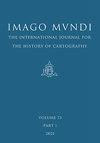描述并测量。18世纪哈布斯堡王朝东部的空间知识。和19。100年
IF 0.5
4区 历史学
Q4 GEOGRAPHY
Imago Mundi-The International Journal for the History of Cartography
Pub Date : 2022-01-02
DOI:10.1080/03085694.2022.2044193
引用次数: 0
摘要
在关于欧洲帝国的史学中,人们对描述、测量和绘制地区以及考虑与之相关的各种政治、经济和社会特征的过程越来越感兴趣。这尤其适用于人口统计、土地税和农业改良计划的分析。2020年,Reinhard Johler和Josef Wolf编辑了一本书,为这一史学领域做出了贡献。Beschreiben und Vermessen基于2009年在图宾根举行的一次会议。它包括21篇与奥地利(后来的奥匈帝国)东部和东南部的“太空知识”(Raumwissen)有关的文章。论文分为三个部分:国家的行政交流和描述、测绘和知识史视角。书评不允许详细讨论每一项贡献,因此,以下段落重点关注地图历史学家特别感兴趣的三个方面。在某些章节中,历史统计以及十八世纪和十九世纪用于创建这些统计的说明发挥了重要作用。例如,彼得·贝克尔强调了指令在这个过程中的重要性,当时社会和经济特征被结构化为标准化的抽象类别(“标准化”)。这些指示形成了一个框架,统计描述的创建者在其中排列了他们所在地区的特征,正如Livia Ardelean为Marmarosch(罗马尼亚)和Rudolf Gräf为Banat(现在分为罗马尼亚、塞尔维亚和匈牙利)所示。在这些章节中,作者研究了当地工作人员如何努力使指示适应各自地区的情况。关于测绘,该卷的作者说明了地图是如何让中央政府真正“看到”这个国家的。土地测量员收到了关于地形特征表示的详细指南,使他们能够制作出起到某种过滤器作用的地图。例如,Xénia Havadi Nagy展示了旨在“优化和加速部队行动”的各种测绘项目的重要性。此外,Borbála Zsuzsanna Török和Reinhard Johler的两章阐述了八世纪和十九世纪的专家如何讨论测量民族志差异的各种方法,以及二十世纪的制图师如何将这些差异转化为民族志地图。这里强调的另一个方面是理解说明、统计和地图是实现政治和行政目的的工具或工具。例如,Robert Born展示了奥斯特-奥斯曼边境的军事地图如何描绘堡垒和其他对未来战争场景有用的细节。与此同时,制图师制作了关于其他各种问题的地图,这些地图在17世纪末和16世纪初被视为“中东欧专题制图的最早例子”,例如显示疫情传播后路线或隔离措施的地图(对于今天的新冠肺炎地图来说,这是多么有趣的历史特征!)。总的来说,这本书对18世纪和19世纪的统计学家、测量师、制图师、官僚和政治家的工作提供了多种有价值的见解。人员和地点的索引有助于在各种贡献内部和之间进行定位。各章显示了不同类型的来源之间的密切关系,如描述、统计和地图。这本书的一个特别之处在于展示了劳姆维森是如何在文本、图表和地图之间进行聚合和转换的,以及这些知识是如何被用来治理奥地利帝国的。本文章由计算机程序翻译,如有差异,请以英文原文为准。
Beschreiben und Vermessen. Raumwissen in der östlichen Habsburgermonarchie im 18. und 19. Jahrhundert
In the historiography about European empires, there is an increasing interest in processes of describing, measuring and mapping areas as well as considering the various political, economic and social features related to them. This applies in particular to the analysis of population statistics, land taxation and schemes for agricultural improvement. In 2020, Reinhard Johler and Josef Wolf edited a volume, which contributes to this historiographical field. Beschreiben und Vermessen is based on a conference held in Tübingen in 2009. It comprises twenty-one essays related to ‘knowledge about space’ (Raumwissen) in the eastern and southeastern parts of the Austrian (later Austro-Hungarian) Empire. The essays are arranged in three sections: administrative communication and description of the country, surveying and mapping, and perspectives of the history of knowledge. A book review does not allow detailed discussion of every contribution, and, therefore, the following paragraphs focus on three aspects of particular interest to map historians. In some chapters, historical statistics as well as the instructions that were used during the eighteenth and nineteenth centuries to create these statistics play a major role. Peter Becker, for example, highlights the importance of the instructions in the process, when social and economic features were structured into standardized abstract categories (‘Standardisierung der Zuordnung von Lebensund Wirtschaftsformen zu abstrakten Kategorien’). Such instructions formed a framework in which the creators of statistical descriptions arranged the characteristic features of their areas, as Livia Ardelean shows for the Marmarosch (in Romania) and Rudolf Gräf for the Banat (now divided among Romania, Serbia and Hungary). In these chapters, the authors examine how local staff tried to adapt the instructions to conditions in their respective areas. With regard to surveying and mapping, the contributors to the volume illustrate how the map enabled the central administration literally to ‘see’ the country. Land surveyors received detailed guidelines regarding the representation of topographical features, allowing them to produce maps that worked as a sort of filter. Xénia Havadi-Nagy, for example, demonstrates the importance of the various mapping projects that had the aim of ‘optimizing and acceleratingmovements of troops’. In addition, two chapters, by Borbála Zsuzsanna Török and byReinhard Johler, illustrate how eighteenthand nineteenth-century experts discussed various methods of measuring ethnographic differences, and how cartographers in the twentieth century channelled these differences into ethnographic maps. Another aspect highlighted here is the understanding of descriptions, statistics and maps as instruments or tools for political and administrative aims. Robert Born, for example, shows how military mapping at the Austro-Ottoman border depicted fortresses and other details useful for future war scenarios. At the same time, cartographers produced maps about various other issues that appear as the ‘earliest examples of thematic cartography in East Central Europe’ during the lateseventeenth and early-eighteenth centuries, such as maps showing post routes or quarantine measures against the spread of epidemics (what an interesting historical feature with regard to present day Covid-19 maps!). Overall, the volume provides manifold valuable insights into the work of eighteenthand nineteenth-century statisticians, surveyors, cartographers, bureaucrats and politicians. Indexes of persons and places facilitate the orientation within and between the various contributions. The chapters show the close relation between the different types of sources, such as descriptions, statistics and maps. It is a particular strength of the book to demonstrate how Raumwissen was aggregated and then transformed between text, chart and map, and how this knowledge was used to govern the Austrian Empire.
求助全文
通过发布文献求助,成功后即可免费获取论文全文。
去求助
来源期刊
CiteScore
0.20
自引率
0.00%
发文量
32
期刊介绍:
The English-language, fully-refereed, journal Imago Mundi was founded in 1935 and is the only international, interdisciplinary and scholarly journal solely devoted to the study of early maps in all their aspects. Full-length articles, with abstracts in English, French, German and Spanish, deal with the history and interpretation of non-current maps and mapmaking in any part of the world. Shorter articles communicate significant new findings or new opinions. All articles are fully illustrated. Each volume also contains three reference sections that together provide an up-to-date summary of current developments and make Imago Mundi a vital journal of record as well as information and debate: Book Reviews; an extensive and authoritative Bibliography.

 求助内容:
求助内容: 应助结果提醒方式:
应助结果提醒方式:


